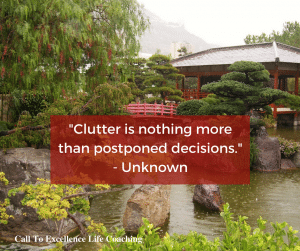
In Part 1 of this series we talked about the 3 main types of clutter – physical, time, and mental – and how each type of clutter distracts us, keeping us from being able to fully focus our energy on our real priorities. In this post, we’re going to tackle the physical clutter. Because it’s visible, in some ways it’s the easiest place to start, and clearing it brings an immediate sense of accomplishment and boost in clarity.
So here are a few tips to get you started on your way to freedom from the physical clutter in your life:
1. Understand the Difference Between Decluttering and Organizing
One thing that I discovered as I dug into this topic is that there is a huge difference between clutter clearing and organizing. Now, the ad agencies who design marketing campaigns for the latest organization gadgets and systems would like you to believe they’re the same thing – “Solve your clutter problem once and for all with our new (shelves, baskets, files, etc…)!!!” And quite a few articles by ‘experts’ on the web listed ‘organizing’ tips under the title of ‘decluttering’.
But here’s the thing – putting your clutter into pretty baskets, or hiding it under the bed in boxes made just for such spaces, or stacking it from floor to ceiling on shiny new shelving in your closet won’t actually solve anything. That’s because clutter is an excess of ‘stuff’ that you don’t use, things that no longer fit you or your current life, and objects that create negative energy or drain you of positive energy. By putting it away in fancy storage units, you’ve contained the clutter, but you haven’t dealt with it. It’s still there taking up space and energy.
Now, I’m not saying that organizational systems are bad. They’re not. But organizing your possessions should be done AFTER you clear out the clutter, not before. Then you can most effectively arrange the things that you truly need and/or enjoy, rather than spending time and money organizing items that you neither want nor need and potentially introducing even more clutter in the process – anyone need a bunch of plastic file boxes that I no longer need?
2. Start with a Plan
Just like a general comes up with a plan before sending his/her troops into battle, it’s best to have a plan of attack in place before you do battle with your clutter. Decide where you’re going to start – you could choose a specific room, or a category of clutter like clothing or old papers or toys. Whatever you pick, start with something easy. This will help you to get some momentum going and give you a sense of accomplishment early on that will help propel you forward when you hit more challenging areas, or when the initial burst of enthusiasm wears off.
Next, get your tools. Most clutter experts recommend a 3-box system: 1 box for items you want to keep, 1 box for things you will sell or give away, and 1 box for trash. You may also want a ‘maybe’ box for those objects that you need a little more time to think about, so you don’t get derailed by a single challenging decision. Come up with a system that works for you – I simply put my ‘keepers’ back where they belong, and have separate bags or boxes for the things I want to sell versus donate.
Finally, plan what you’re going to do with the stuff you’re selling or giving away before you get started. Where specifically will you take it, or who will you give it to? Identify consignment shops or organizations that are looking for used electronics or household goods. Put a garage sale on the calendar. Having a plan for removal will prevent you from winding up with a stack of boxes or bags of junk sitting in your garage for months.
3. Tackle the Clutter in Manageable Chunks
For many people, the idea of cleaning up the clutter in their entire home or office, or even just one room, in a single marathon session makes them curl up on the couch in a fetal position, remote control clutched tightly in their hands, searching frantically for an addictive Netflix series so they can put off thinking about it for at least one more weekend.
Or maybe that’s just me.
But I suspect I’m not alone, even if your method of procrastination is a little different than mine. The great thing is, you don’t have to tackle decluttering your environment all at once. In fact, it’s not realistic to think you’re going to clear out several years’ worth of accumulated clutter in a day, or even a weekend, unless perhaps you hire a professional to help.
You’ve probably heard the old joke, “How do you eat an elephant? One bite at a time.” Well, that same principle also applies to large and potentially overwhelming clutter clearing projects. Decluttering is no different than any other big, intimidating project, and the secret is to break it down into small manageable chunks of either time or territory.
For some people, setting a timer and dedicating a predetermined amount of time to clearing the clutter, either daily or weekly, works well. The key here is to keep the amount of time you spend on the project well within comfortable limits, so you end your session feeling energized, like it was no big deal, rather than exhausted. If you use the timer method, you need to commit to doing it regularly, but as long as you’re consistent, you’ll be amazed at how even the smallest increments of time add up. For example, I used this strategy, dedicating just 5 minutes a day over the course of about a month or two, to painlessly eliminate several file boxes full of old papers and a few stacks of loose notes .
For others, it may help to divide the project into discrete spaces – picking one room to start, even narrowing it down to a single drawer/shelf/pile to tackle in one session. You’ll get the most bang for your buck with this approach if you pick a space that you can complete within a single session, so you end the session with a feeling of completion and success.
Another variation on this theme is to challenge yourself to get rid of at least one piece of clutter a day or 10 items weekly (or whatever numbers work for you). The key here again is consistency, but you’ll be amazed at how quickly the number of items you’ve purged adds up.
4. Take Time to Review Everything in the Area You Are Clearing
If possible, move everything from the space or category you’re working on to a separate ‘staging’ area for the sorting process. Dump the drawer on an empty table, haul all of the clothes out of the closet and toss them on the bedroom floor, pile the old files and boxes of unidentified ‘stuff’ in the spare room. You want to remove the clutter from its usual environment, and put it in a place where you can process it more objectively. And ideally, you want to put it somewhere that motivates you to deal with it and get it cleared up – if the dinner table is covered with the detritus of the junk drawer, you’re going to feel compelled to finish clearing that clutter so you can eat dinner.
5. Separate the Gems from the Trash
The next step is determining what you’re going to keep. Julie Morgenstern, author of “SHED Your Stuff, Change Your Life”, calls this step ‘separating your treasures’. Treasures can be either practical items that contribute to your life in a specific way, or meaningful items, “symbolic or sentimental objects or activities that bring you pure and unambiguous joy, energy, and inspiration.” Morgenstern estimates that only 10% to 20% of the items in your inventory are true treasures. Remember, the more stuff you let go of, the more room you create for the life you really want.
Marie Kondo, author of “The Life Changing Magic of Tidying Up,” recommends holding each object, and asking if it “sparks joy in your heart.” If that’s a little too woo-woo and your stuff doesn’t send you any obvious vibes, try asking yourself a few practical questions:
- Imagine you had just lost everything in a disaster, like a fire or a flood. What would you replace immediately? What would you most regret losing? These are your keepers.
- Have you used it in the last 6 months (or 1 year for seasonal items)?
- If it’s broken or damaged, what would it cost to get it repaired (including time and hassle), compared with buying a new one, if indeed you even still need it?
6. Take Out the Trash
That leaves a pile of the rest of the stuff, most of which needs to go away in some way, shape, or form. Remember those boxes labeled ‘donate/sell’ and ‘trash’? Start filling those suckers up.
Sometimes it can be helpful to get someone else involved with this step, someone who can push past misplaced sentimentality and regrets over money spent, and help you see your stuff in a more objective, rational light. If you find yourself stuck at this step and unable to part with anything but the most broken, stained objects, try inviting over a trusted friend, or hiring a professional organizer. After hemming and hawing over revamping my wardrobe for at least two years, and then staring at the contents of my closet lying on my bedroom floor for over two weeks, I finally enlisted the help of a professional wardrobe consultant – in just two hours my wardrobe purge was complete. One of the best investments I ever made.
7. Prevent Clutter from Finding Its Way Back In
Once you finish clearing your clutter, all that empty space will feel refreshing and energizing. You won’t be able to imagine going back to your old ways. But you need to be on guard, because clutter is sneaky, and it always seems to find a way to find its way back into your life. You have to be vigilant if you want to keep your surroundings spacious and peaceful.
First, be mindful before buying or accepting something new. Ask yourself where you will put it and how you will use it. Ask yourself if you really love/need it, or are you shopping to soothe some other need? It can also help to put in place certain “rules,” like the “1 in – 1 out” rule, where for every new item you bring into your home, you find an old item to discard or donate.
Second, recognize that clearing clutter isn’t a one-and-done event. Despite your most diligent efforts, clutter will start to accumulate because as you grow and your life changes, the things you love and/or need will change too. Outgrowing your stuff is a natural part of life. So make decluttering a regular part of your routine. Just as you should take time monthly or quarterly to examine your goals and your progress towards them, doing a sweep of your space at regular intervals to root out the things that no longer fit your current life will keep your clutter-free lifestyle on track.
Up Next
Stay tuned for Part 3, where we’ll take a look at ways to tackle time clutter to create margin in your life, and Part 4, where we’ll start to talk about ways to deal with mental clutter.
I’d love to know if you have any additional tips that you’ve found helpful for clearing out physical clutter, or what kind of changes you’ve noticed after you’ve decluttered your space – please share in the comments below!







15 thoughts on “7 Tips for Reducing the Physical Clutter in Your Home and Office (Clutter Part 2)”
I think decluttering vs. organizing is one of the things I struggle with most. Sometimes I need to remind myself that just because I have an empty spot doesn’t mean I need to put something in it.
LOL, I can relate to the urge to filling up any and every empty space, I used to do the same, but now I have come to enjoy seeing empty spaces – it gives me the feeling that I have room to breathe.
I liked the last point you mentioned, prevent clutter from finding its way back in. We take time organize everything and later on get something and put it in a place we just freed.
Exactly! And it’s so much easier to prevent clutter than to get rid of it.
What I got out of this is that shifting our mindset and practice goes hand in hand, and that clearing clutter is not simply a one time job. We must continue to be vigilant of recluttering our homes, our life, and this consciousness. Thanks Susan for this brilliant reminder. Xo, Evelyn, PathofPresence
Yes! It’s a matter of developing a habit of clarity and spaciousness in our homes, our minds, and our lives, and that is an ongoing process.
Declutter is the first step and I am forever struggling in this department.Helpful tips to get started.
i literallyy just had to get rid of SO much clutter! crazy how much could get built up in a short amount of time.
Yes, it can catch up with us quickly! But I’ll bet you felt so much better when you cleared it out – good job!
I gotten a bit of clutter out! These are great tips, everything seems to work out well when you plan
Thank you, and good job on clearing out your clutter! Planning makes everything easier.
This post makes me what to start right away! Great tips!
Awesome! Go for it – clearing your clutter can be life changing!
Love the name of your blog and great article.
Thank you! Glad you enjoyed it.